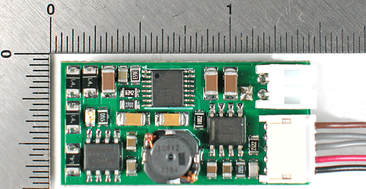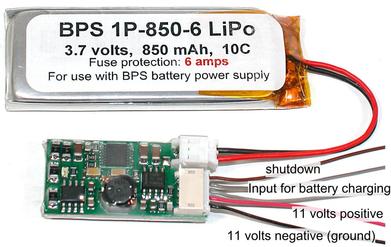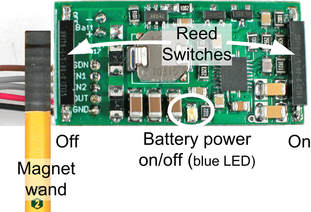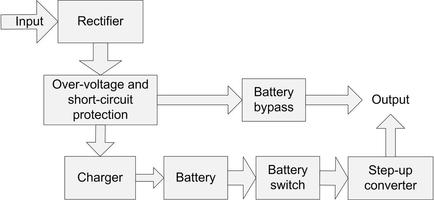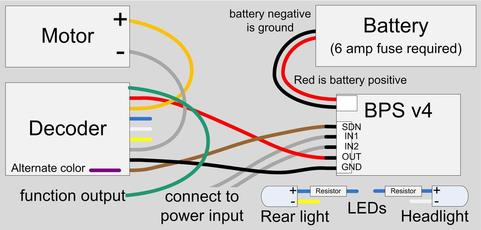This fourth generation BPS power supply is intended for on-board battery power installations requiring up to 1 amp from a package small enough for installation in HO, On3, On30 models. It's also a good choice for S scale models with efficient can-type motors.
|
Energy is provided by one or more lithium polymer (LiPo) cells connected in parallel and higher voltage output is produced electronically using a step-up converter. Battery charging, protection and switching are also included in one, small double-sided circuit board assembly.
|
Improvements
|
Battery ChargingBattery charging power can be from track or a connector.
|
Power source can be DC, DCC or AC
Warning: Many hobby-type DC train controllers do not produce filtered DC output and peak voltage can be as high as 3 times a DC measurement. |
6 amp Battery Fuse
Batteries for previous versions of BPS included a 3.5 amp fuse and used insulation displacement battery plugs.
At 1 amp load, BPS v4 consumes up to 4 amps from the battery, which requires a 6 amp battery fuse, heavier leads and a crimp-style plug.
At 1 amp load, BPS v4 consumes up to 4 amps from the battery, which requires a 6 amp battery fuse, heavier leads and a crimp-style plug.
Battery BypassPower can flow from input to output though battery bypass. It can also flow from battery via battery switch to step-up converter.
The path that delivers higher output voltage supplies most (or all) output power.
If track voltage is high enough (12 or more volts), bypass voltage exceeds 11 volts and track power supplies output as well as battery charging. Battery energy is consumed only when needed to substitute for track power.
|
BPS is the ultimate keep-alive power source. A small battery can sustain a long operating session with some help from track power. |
Over-voltage and short-circuit protection
The protection block in the above diagram protects against three abnormal conditions.
- Excessive input voltage: Turns off input when voltage exceeds 20 volts and restarts at 18.5 volts. Since protection is virtually instantaneous, voltage spikes, peaks, as well as sustained conditions are controlled.
- Overload: Rectifier output is limited to 1.2 amps, which is comfortably within the 2 amp rating of the rectifier diodes.
- Short-circuit: Fast trip (less than 1/4 msec.) occurs at 2 amps.
Decoder Off command
By default, S-CAB installations with SoundTraxx or NCE decoders are set up to use a decoder ‘F5’ command to shut down battery power. This requires connection of the BPS shut-down wire (brown) to the appropriate decoder function output as shown in the above diagram. For SoundTraxx, this is a brown wire (output FX4); for NCE decoder, the wire color is purple/violet.
BPS as a general source of on-board power
If a locomotive or traction model needs on-board DC power, BPS can do the job so long as demand does not exceed 1 amp. Temporary overloads up to 1.2 amps are okay. Standard output voltage is 11 volts, but can be customized within a range from 9 to 12 volts.
